Rights-of Way on Public Lands and Administrative Avoidance

Rights-of Way on Public Lands and Administrative Avoidance
Century old rights-of-way uses of public lands can only be confirmed through a long, expensive federal court process. Because the Bureau of Land Management (BLM) and U.S. Forest Service (USFS) cannot determine the validity of water delivery and road rights-of-way on public lands, farmers, ranchers, and local governments may face an uphill battle to legally confirm and adjudicate these long-standing uses.
Revised Statutes (RS) 2477 and 2339 were components of the Mining Law of 1866, also called H.R. 365. This Act recognized the activities of settlers and miners occupying the West and encourage development of federal lands.
RS 2477 recognized roads and highways on public lands not already withdrawn from entry. RS 2339 protects the use of water infrastructure used for mining, agriculture, manufacture, and other purposes in place prior to the lands being withdrawn as well. These road and ditch laws honored development protocols and uses based on the local custom and laws at the time of early settlement.
While these laws are no longer in effect with the passage of the Federal Land Policy and Management Act (FLPMA), these self-granting rights-of-ways created while the law was in effect have not disappeared. FLPMA recognizes existing rights on public lands prior to its passage. See: http://www.blm.gov/ca/dir/pdfs/2003/ib/CAIB2003-023ATT2.pdf
Without a way for agencies to definitively determine RS 2477 and RS 2339 rights-of-way claims, federal courts are currently the only venue to address these issues. For more information, see: http://nvbar.org/articles/content/rs-2477-public-rights-way-era-administrative-avoidance
Make sure to stay tuned to Schroeder Law Offices’ Water Blog for more news that may affect you!
This article was drafted with the assistance of Law Clerk Jakob Wiley, a concurrent student at Oregon State University’s Water Resources Policy and Management graduate program and a law student at the University of Oregon School of Law.

 With the political race underway, one group has taken a hard look at land management objectives on federal lands. In response, this group prepared a list of the top ten ways to improve federal land management in an open letter to the United States Presidential Candidates. In summary, top ten items include:
With the political race underway, one group has taken a hard look at land management objectives on federal lands. In response, this group prepared a list of the top ten ways to improve federal land management in an open letter to the United States Presidential Candidates. In summary, top ten items include:



